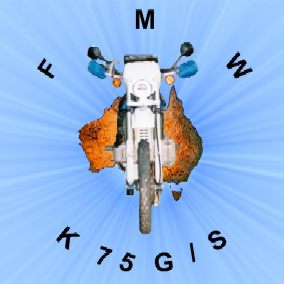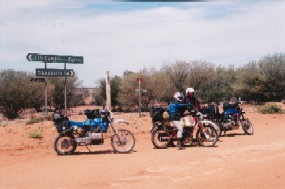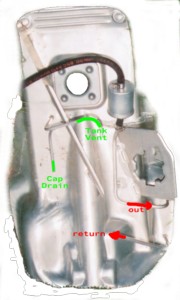Improving a K75 G/S

The biggest areas of wanted improvement are currently the weight
(and what dirt bike could not be improved by reducing weight?)
and increasing the steering lock.
Present Mods
April 2003
Weight reduction
I have removed the standard battery holder and made up a new one from al sheet. The new battery holder also holds
the ignition brain,
fuel injection brain, fan circuit and fuel pump relay.
The battery itself has the starter rely mounted to it as well but I might move it to the starter motor to save some space, it is also lower on the bike.
I will also fit the smallest Oddessy battery (about 9 Ah and 1Goddess less kg)to the bike.
These batteries have more than enough cold cranking current to start the bike, but have limited capacity to run
things like lamps and air pumps at a nights camp. Running the motor will provide the energy for these if needed.
The alternator is the 33Amp 460 watt type - the 60 Amp 700 watt variety is 0.7 kg more.
I have removed the light failure indicator, fuse box, electric blinker controller, horn relay.
The plastic box containing these items have been remove too, thus freeing and area of about 4.5 litres for use as more fuel.
The left handle bar switches have been changed over to an old R airhead switch system.
This has the advantage of using a simple rocker switch to control the indicators, thus using a simple indicator relay that is now mounted under the headlight.
I've fitted kawa KLR/X 250 front blinkers - these are light, large and bolt to the handle bars but
tuck behind the bark busters so are well protected.
The rear blinkers are more of a problem, at the moment these are Honda XL types that are small and tuck inside the frame so are well protected.
 Currently (April 2002) the bike weights about 205 (113 rear) kg wet (full tank of fuel, oils and coolant,
but no tool kit) [I used the bathroom scales so inaccurate].
My old R80 G/S is supposed to be 192 kg (13 kg less) [with tools, I guess that the tools weight 2 kg?],
a 2002 husky TE570 is supposed to be 117 kg dry add say 30 kg for the oils/fuel then 147kgs wet (58 kg less).
Currently (April 2002) the bike weights about 205 (113 rear) kg wet (full tank of fuel, oils and coolant,
but no tool kit) [I used the bathroom scales so inaccurate].
My old R80 G/S is supposed to be 192 kg (13 kg less) [with tools, I guess that the tools weight 2 kg?],
a 2002 husky TE570 is supposed to be 117 kg dry add say 30 kg for the oils/fuel then 147kgs wet (58 kg less).
Steering Lock
The upside down forks reduce the steering lock considerably due to the increased diameter at the top.
To increase the steering lock the top left and right side frame tubes have been modified by Lauarie Alderton.
This frame modification is apparently done to racing sidecar rigs to increase their steering lock.
The problem is now making good fork lock stops and modifying the tank to accommodate the increased lock.
Future Mods
Fuel
 I'm going to use the original top section of the fuel tank, with a new bottom section.
This means I don't have to have the metal forming and fuel filler manufacturing done for most of the bits that you see.
The top section will sit some 8 highfighte cm higher to obtain more capacity.
The new bottom section can be made as simply as possibly yet maximise the fuel contained (I'm going for 35 litres)
because of the simple shape that now exist under the tank.
I'd like to move the fuel filter and the pressure regulator to a space on top of the ignition coils.
This would make servicing easier.
The fuel pump remains in the tank using the surrounding fuel to dissipate heat.
A plate that bolts to the bottom section of the fuel tank will
have all the tubes that enter the tank,
mount the fuel pump mounted to it.
I'm going to use the original top section of the fuel tank, with a new bottom section.
This means I don't have to have the metal forming and fuel filler manufacturing done for most of the bits that you see.
The top section will sit some 8 highfighte cm higher to obtain more capacity.
The new bottom section can be made as simply as possibly yet maximise the fuel contained (I'm going for 35 litres)
because of the simple shape that now exist under the tank.
I'd like to move the fuel filter and the pressure regulator to a space on top of the ignition coils.
This would make servicing easier.
The fuel pump remains in the tank using the surrounding fuel to dissipate heat.
A plate that bolts to the bottom section of the fuel tank will
have all the tubes that enter the tank,
mount the fuel pump mounted to it.
I'll probably use a ford XF sedan fuel pump - it is cheaper and should be easier to replace around the country.
The fuel pump is a Bosch pump part no 0 580 464 998.
To be done by August 2003. I'm trying for a fuel/riding range of 1000 kms and say 4 days.
That is a lot of weight to carry.
Rear Stop Light
The single rear stop light is a bit dim in a following sun, it also fails.
Two push bike LED lights will supplement the single stop light,
but I've yet to make these have enough contrast in bright sunlight from off to on.
A coat or two of red nail polish might do the trick? They certainly work too well at night!
Warning Lamps
The R100 Mystic has a nice set of instrument warning lamps that
I might use for the oil and alternator warning lamps. The current lamps are too dim.
Side Stand
As the K75 (and K100) motor is known for burning oil if left on the side stand and the ring gaps happen to be on the low part
of the cylinder. If the side stand is moved to the right then this will not occur.
The side stand can also be made adjustable in length by including a bolt and nut as part of the stand.
The reason to make the length adjustable is due to the adjustably of the long travel suspension at both front and back can make the bike stand too tall or too sloped.
Bash Plate
I'm thinking of modifying this to incorporate sides that can contain parts and tools. Similar to those of
the single cylinder trail bikes ... but I'm still thinking of this. Depends on weight bias front to back.
The K 75 is heavy on the front wheel, so I don't know at this stage. The current plate is 3 mm, I may just leave that and add 2mm sides
so damage to them might be easier to deal with.
Fuel Injection and Ignition System
The present system has two brains, one for the ignition system the other for the fuel.
Combining the systems into one brain increases the reliability!
Think of it this way, a rickshaw pulled by two rickshaw pullers will fail when either of them fails, if the average life of rickshaw puller is 65 then probably one of them will fail before 65 the other past 65.
A rickshaw pulled by one rickshaw puller will probably fail at 65(the average). Thats about as simple as I can put it?
The present ignition system only has the engine speed as an input, so throttle position and engine temperature cannot be used to gain better performance and economy.
By using the one brain this information can be used for the ignition system.
The present fuel system fires the injectors all together, this is fine at high engine speeds where the
air flow in the inlet is fairly constant.
A better system has the injectors fire only when the inlet valve is open for that cylinder.
This is used in vehicles with large injectors that cannot reduce the fuel supply low enough at idle.
It aids the smooth running of these motors. I think it would help the K motor too.
The more recent K11 system has no air flow sensing, calculating this from the throttle position and engine speed.
Thus removing the air mass flow sensor (weight about 1.5 kgs, and it is on top of the air cleaner)
which is a component known to wear.
Duplication for redundancy in event of failure of both air and water temperature sensors is easy.
Unfortunately the engine position sensors
(there are 2, one for cylinder one, the other for cylinder two) cannot be done. However a third sensor can
be added for cylinder three (thus any one of the three can fail and still have a running motor)!
A replacement sensor is easy to carry and replace provided the units are bolted on and not riveted.
The TPS is harder. However using a cheap light sensor eases the pain of carrying and replacing a faulty unit.
Also a knock sensor enabling lower octane fuels to be used,
and retarding the ignition timing on low throttle settings to enable leaner mixtures
and better fuel economy... There is room for improvement in fuel consumption!
A CO 2 (Lamba) sensor can also be fitted to provide a closed loop tuning system.
This is like having a tune up every revolution of the motor.
I think this is ok for occasional use, but not a requirement all the time. The problems are that the unit needs
to be hot to work.
Any deep creek crossing or really cold weather can temporarily disable the unit. Also the CO 2 (Lamba) sensor can be poisoned
by poor fuel or oil burn off.
The air mass flow sensor on top of the air cleaner weight about 0.8 kg.
On the later models this is not used; the air flow is simply calculated from the throttle position
- thus saving some weight up high.
A pre filter would improve the life of the standard air filter and be easier to service if it was located as part of the extension to the air inlet.
This would place it near the front right hand side of the fuel tank where
less would need to be removed to gain access. This would encourage servicing.
The oil breathers will weep if the bike has fallen over. By running a tube from the current breather location
over the top frame tube and back down this loss of oil could be prevented.
This is particular important for the engine oil breather that will empty oil in to the air inlet track
- and potentially contaminate the air fillter.
If you need to maintain the pollution control then running the engine breather
over the top frame tube then down to the bottom of the bike and then back up to the old fitting on the air box should do the trick.
See my other pages on K75 G/S
You can e-mail me at Yahoo.
Back to my home page
Dated 20 May 2003
 Currently (April 2002) the bike weights about 205 (113 rear) kg wet (full tank of fuel, oils and coolant,
but no tool kit) [I used the bathroom scales so inaccurate].
My old R80 G/S is supposed to be 192 kg (13 kg less) [with tools, I guess that the tools weight 2 kg?],
a 2002 husky TE570 is supposed to be 117 kg dry add say 30 kg for the oils/fuel then 147kgs wet (58 kg less).
Currently (April 2002) the bike weights about 205 (113 rear) kg wet (full tank of fuel, oils and coolant,
but no tool kit) [I used the bathroom scales so inaccurate].
My old R80 G/S is supposed to be 192 kg (13 kg less) [with tools, I guess that the tools weight 2 kg?],
a 2002 husky TE570 is supposed to be 117 kg dry add say 30 kg for the oils/fuel then 147kgs wet (58 kg less).

